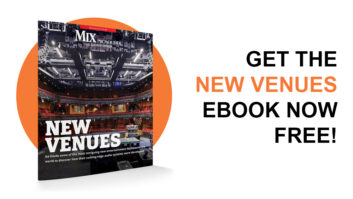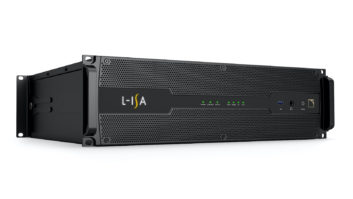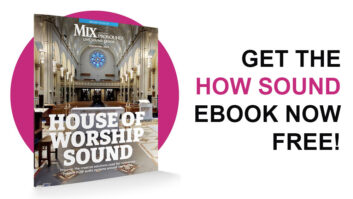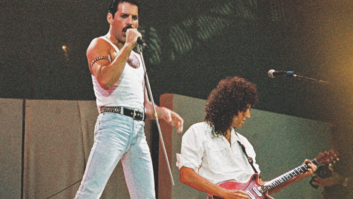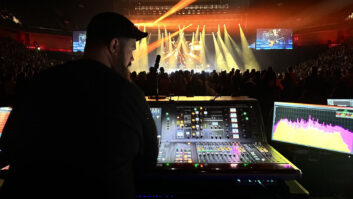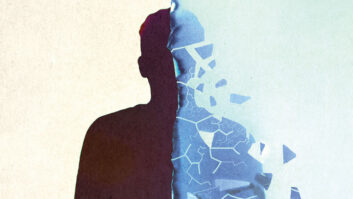
Orlando, FL—While every major sports league has been challenged by reopening during the pandemic, no approach has captured the public’s imagination quite like the NBA Bubble: Take 22 teams, their support staffs and all the necessary production crew to broadcast two and a half months of basketball, and then seal them up inside the Walt Disney World Resort in Orlando, FL, like a giant Tupperware container. Inside the Bubble, they have everything they need to finish the 2019–20 NBA season except one: fans. That’s where live sound provider Firehouse Productions (Red Hook, NY) comes in.
“When the NBA season stopped on March 11, we had just finished [providing live sound for] the All-Star Game two weeks prior,” recalled Mark Dittmar, vice president at Firehouse. “LeBron James was on TV saying he would never play basketball without fans because the fans are everything to him. And the next morning I woke up with this very strange idea in my head of ‘what if he didn’t know there weren’t fans.’ I called the NBA—a very good client of mine—pitched an idea, and within a week they’d bought in fully and we started preparing for the first tests.”
The idea was simple: Fill an empty arena with crowd sounds to create the familiar aural background that players are used to. Like all simple ideas, it turned out to be not simple at all.
With all systems go, a 38-person team from Firehouse headed to Florida on July 1 with four semitrailers full of hardware. When they arrived, they began loading systems into the ESPN Wide World of Sports Complex at Disney World.
The Gear of Damian Lillard’s Mini-Studio Inside the NBA Bubble, by Clive Young, July 31, 2020
All NBA games are played on three courts during this transformed 2020 season: the Arena, the main court on which many televised games and all NBA Finals matchups will take place; the HP Field House, a secondary court used for televised games until the finals; and the Visa Athletic Center, used mainly for non-national games. While there were initially plans to just put one P.A. of crowd sounds into each venue, that quickly became two P.A.s: the court P.A. and the audience P.A.
“It may sound strange to say ‘audience P.A.’ in a game where there’s no audience, but because there are hundreds of people in the Bubble here, we actually have a fully [COVID-19] tested audience, so they’re letting players and staff members go watch other games if they want—and that audience needs a P.A.,” said Dittmar.
Each venue’s court P.A. system is the same: 10 hangs of six loudspeakers, with six low hangs and four hangs placed at a high angle to make sound from upper decks sound more authentic. The Arena’s court P.A. gets L-Acoustics K2 boxes, while the other two venues get KARAs. Meanwhile, the audience P.A. in the two main venues consists of three hangs of eight JBL VTX V20s with VTX S25 subs, supported by additional Firehouse F12s on the upper deck delays.
“The court system is a DiGiCo SD7 at 180 or 190 inputs at this point; with how the immersive sound works, that chews up 30 channels right there,” said Dittmar. Figure 53’s QLab multimedia playback software is used to trigger the immersive audio.
One of the most crucial—and agonized over—aspects of the entire project has been the actual sounds played through the crowd P.A.—a process they’ve labeled “atmospheric engineering” because the industry-standard term, “sweetening,” which denotes adding sound to an existing full crowd, does not apply here. Once the NBA signed off on the project, Firehouse had to put together a content development team and start creating a library of sounds—another seemingly simple project that turned out to be anything but.
Firehouse Productions helped stage a one-time performance of the Broadway show To Kill a Mockingbird at Madison Square Garden in January, as well as a Misfits show at MSG in late 2019.
“We started off with sounds from the video game NBA 2K, but they were contaminated,” laughed Dittmar. “They have referee whistles and sneakers squeaking—things that we can’t put out on the court. When we heard the whistles, our first thought was to try to remove those things, but that became way too labor-intensive, so we had to start from scratch.”
By the time the season restarted on July 30, the content development team had compiled more than 900 sound files, drawing on everything from sound effects libraries to edited real-life games to original Foley work. With the season underway, the content team is still adding material, refreshing the content libraries and adding unique sounds like team-specific defense chants and more. “To make it realistic, you’ve got to keep going,” said Dittmar. “In the QLab file, every time someone hits a certain level of cheer button, it’s doing something different. The operators have 128 buttons, and those buttons have hundreds of randomized things happening under them. At any given moment, there are 50 to 70 cues running simultaneously to get us a layered effect.”
The atmospheric engineering team comprises four people: two operators, an NBA producer and a music coordinator/DJ, all of whom can fire sounds. “They all have different parts of the story that they tell,” Dittmar explained. “This is not a mixing job; it’s a musician’s job, and they are playing the audience very much like an instrument. When a moment gets boring, they actually have to convey with sound that the moment is boring, not just sit there and be bored. When it gets exciting, they have to switch and convey that. Is the audience mad and leaving because their team is losing badly? These are all stories that we are capable of telling.”
The potential problem is that operators might affect the bigger story, too. An endless run of booing and jeering from an invisible crowd could easily undermine a team’s performance, and managing that is a huge responsibility.
“The question is, how realistic do you go? That is a big, ongoing topic of conversation, because we are capable of going very realistic, but is it appropriate for us to do that? We want the players to have good energy, we want them to be comfortable, we want it to sound great on air and we want everyone at home to have a great experience—so it’s not just ‘cheering a game.’”
Prior to each game, the atmospheric engineering team plays 90 minutes of murmur—the sounds of 6,000 to 18,000 people sitting in a quiet arena. During the game, the team generates about 60 percent of the crowd sound, creating a bed that resides beneath both the in-person crowd and vocal online fans participating via a collaboration with the NBA and Microsoft Teams.
“The first time we actually put sound out on the court was tense because we didn’t know how the players were going to react,” Dittmar recalled. “And like anything you do, even if you knock it out of the park, 80 percent of the people like it and 20 percent don’t. The players have given us some excellent feedback and we’ve been massaging [the audio] ever since.”
It’s just another aspect of making the Bubble work—a massive commitment at every level, including the audio team, which had to be literally locked in their hotel rooms for a week under quarantine when they arrived in Orlando. As the games continue, some audio team members will get to head home, while the remaining pros continue to work and get tested for the coronavirus daily. By the time the season is over on Oct. 12, they’ll have been there for three and a half months.
“It’s somewhere between The Truman Show, Groundhog Day and Edge of Tomorrow,” laughed Dittmar, “but it’s been great. It started as a small idea and grew into far more than I ever envisioned. The NBA has been completely supportive of doing this the correct way, too—not just treating our guys safely, but also the fact that we have an entire extra team of people down here in rotation so that people can get days off, or so that if people get sick, we can correctly quarantine. We haven’t had that situation, but that right there is a huge gift. From the very beginning, they’ve said, ‘We’re going to go for it. We’re going to do it right.’”
Firehouse Productions • www.firehouseproductions.com
NBA Restart • stats.nba.com/returntoplay2020
